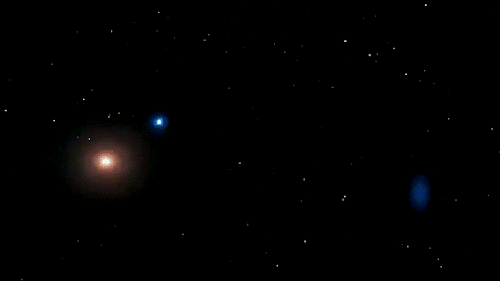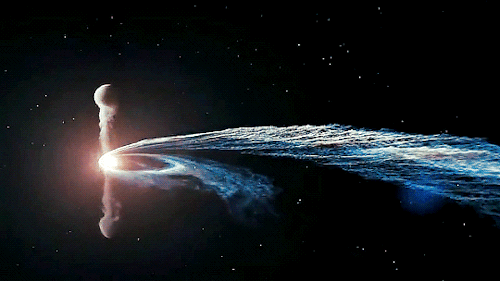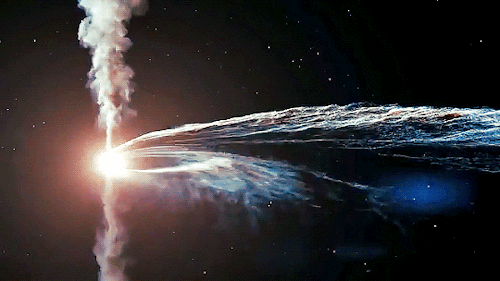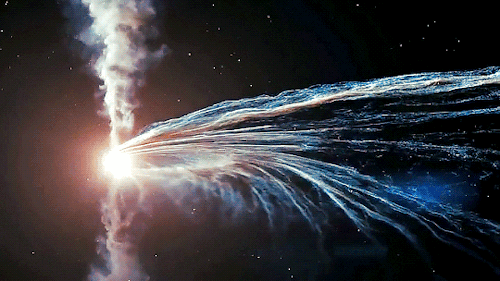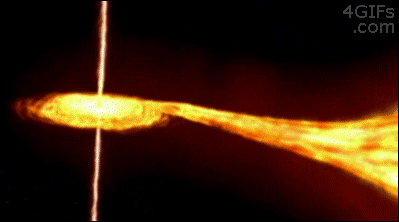Your personal Tumblr library awaits
BLACK HOLE - Blog Posts


Sagittarius A* design
i’m sat
general relativity for babies

Black hole
They are both 35 times bigger than the Sun, of which you can fit 1,000 Earths, they collide in space and the only thing I'm now thinking is...why does it make such a funny noise...surely I'm not alone in this!!!
In an unprecedented discovery released on July 6, 2023, Webb Telescope Discovers Most Ancient Supermassive Black Hole

The James Webb Space Telescope, humanity's next-generation space observatory, has once again astounded scientists and astronomers with a groundbreaking discovery. In its Cosmic Evolution Early Release Science (CEERS) Survey, the Webb telescope team has successfully identified the most distant active supermassive black hole ever recorded. Situated within the galaxy CEERS 1019, this remarkable black hole emerged just over 570 million years after the cataclysmic event known as the Big Bang. Astonishingly, it possesses a mass equivalent to a mere 9 million times that of our Sun. Read full article here



#black-hole planet painting by -
Kerstin Jacobs
http://little-starlight-galaxy.eu7
It can be a very heavy planet into the gravity rotating around something, or not, in Spanish
\(*0w0)/
¿Qué hay dentro de un agujero negro? ¿Qué le podría pasar a la Tierra si...
Galaxy Center

Picture of the day - November 6, 2018
The center of the Large Magellanic Cloud Galaxy, according to space engine.










Triangulum Log - Post 1 - The Outskirts.
My first adventure brings us to this Yellow Super Giant and companion black hole. The system is young and filled with many gas giants that still glow with the heat of their formation.
All of the planets orbit far from the star, the nearest having a orbital radius of 10.57 AU. Numerous planets are also double planets including a double Jupiter as shown above.
More pics of this system and my thoughts on if this system could actually exist in the real universe to come.

New Zealand was lovely, but I already touched on what I’d be tempted to talk about with my Southern Stars episode. A person I interviewed as a potential new housemate gave me the idea for this episode because the joy of outer space is truly everywhere and anywhere. The field of astrogeology was not something I had heard of before, though I had indirectly heard of Eugene Shoemaker. I knew the comet Shoemaker-Levy 9 was named after him (and Carolyn Shoemaker, his wife). It turns out he basically founded the modern field of astrogeology! So I talk about him for quite a while, too.
Below the cut are the glossary, transcript, sources, and music credits. Send me any topic suggestions via Tumblr message (you don’t need an account to do this, just submit as anonymous). You can also tweet at me on Twitter at @HDandtheVoid, or you can ask me to my face if you know me in real life. Subscribe on iTunes to get the new episodes of my semi-monthly podcast, and please please please rate and review it. Go ahead and tell friends if you think they’d like to hear it, too!
(The next episode is definitely going to be on famous comets, and I’m hoping to publish that episode in May.)
Glossary
active galaxy - a galaxy with a small core of emission embedded at the center. This core is typically very variable and very bright compared to the rest of the galaxy. These galaxies emit much more energy than they should; this excess energy is found in the infrared, radio, UV, and X-ray regions of the electromagnetic spectrum.
black hole - a region of spacetime where a great deal of mass and energy have been compressed into a relatively small space. Black holes exert such strong gravitational effects that no mass or energy, not even light, can escape from inside them. There are supermassive black holes in galaxies that contribute to the development and life cycle of galaxies.
blazar - a subcategory of active galaxy, it is an extremely bright, distant object, powered by a black hole, which emits massive amounts of energy. It is distinct from a quasar because it is even brighter.
interferometry - a group of techniques to extract information from superimposing electromagnetic waves to create interference. In radio astronomy, this is done by using a wide spread of receivers to look at the same distant object, then bringing that data together with a correlator that can create a larger, clearer picture than an individual radio telescope alone could.
Messier object - a deep-sky object included on a list of 103-110 deep-sky objects made by Charles Messier and his colleagues in the 18th century in an attempt to prevent fuzzy, bright objects from being confused with comets.
torus - a donut shape.
quasar - a distant, massive celestial object that emits extremely large amounts of energy. These star-like objects may reflect a stage in the evolution of some galaxies.
Script/Transcript
Sources
Black Holes, explained via National Geographic
What Is a Black Hole? via NASA
Black Holes via NASA
Black Hole via Swinburne University of Technology
Darkness Visible, Finally: Astronomers Capture First Ever Image of a Black Hole via the New York Times (April 2019)
Event Horizon Telescope
Astronomers Capture First Image of a Black Hole via ESO (April 2019)
How They Took the First Picture of a Black Hole via New York Times (April 2019)
Intro Music: ‘Better Times Will Come’ by No Luck Club off their album Prosperity
Filler Music: ‘Flame On Flame (A Slow Dirge)’ by Kishi Bashi off his album Sonderlust
Outro Music: ‘Fields of Russia’ by Mutefish off their album On Draught










Black Holes Are Real And Spectacular, And So Are Their Event Horizons
“Originally estimated to be slightly larger than its M87 counterpart, the black hole at the center of the Milky Way — known as Sagittarius A* — has not yet had its event horizon imaged. When you observe the Universe, you don’t always get what you expect; sometimes, you get what it gives you. Instead, it was M87’s black hole that came through first, which was a much brighter and a much cleaner signal.
What we’ve found is spectacular. Those dark pixels at the center of the image are actually the silhouette of the event horizon itself. The light that we observe comes from the accelerated, heated matter around it, which must emit electromagnetic radiation. Where the matter exists, it emits radio waves, and the dark circle we see is where the background radio waves are blocked by the event horizon itself.”
We have an event horizon, folks! It wasn’t the one at the center of our galaxy that came through first, but rather the one at the center of Messier 87: a black hole over 1,000 times more massive, but some 2,000 times farther away, than the one contained in the Milky Way. This is an ultramassive black hole that’s almost the size of the entire Solar System, and its event horizon is real.
Come get the full story on what we know, now that we have our image, about black holes in the aftermath of the Event Horizon Telescope!
NASA's Swift Mission Maps a Star's 'Death Spiral' into a Black Hole
NASA - Swift Mission patch. March 20, 2017 Some 290 million years ago, a star much like the sun wandered too close to the central black hole of its galaxy. Intense tides tore the star apart, which produced an eruption of optical, ultraviolet and X-ray light that first reached Earth in 2014. Now, a team of scientists using observations from NASA’s Swift satellite have mapped out how and where these different wavelengths were produced in the event, named ASASSN-14li, as the shattered star’s debris circled the black hole. “We discovered brightness changes in X-rays that occurred about a month after similar changes were observed in visible and UV light,” said Dheeraj Pasham, an astrophysicist at the Massachusetts Institute of Technology (MIT) in Cambridge, Massachusetts, and the lead researcher of the study. “We think this means the optical and UV emission arose far from the black hole, where elliptical streams of orbiting matter crashed into each other.”
Swift Charts a Star’s ‘Death Spiral’ into Black Hole
Video above: This animation illustrates how debris from a tidally disrupted star collides with itself, creating shock waves that emit ultraviolet and optical light far from the black hole. According to Swift observations of ASASSN-14li, these clumps took about a month to fall back to the black hole, where they produced changes in the X-ray emission that correlated with the earlier UV and optical changes. Video Credits: NASA’s Goddard Space Flight Center. Astronomers think ASASSN-14li was produced when a sun-like star wandered too close to a 3-million-solar-mass black hole similar to the one at the center of our own galaxy. For comparison, the event horizon of a black hole like this is about 13 times bigger than the sun, and the accretion disk formed by the disrupted star could extend to more than twice Earth’s distance from the sun. When a star passes too close to a black hole with 10,000 or more times the sun’s mass, tidal forces outstrip the star’s own gravity, converting the star into a stream of debris. Astronomers call this a tidal disruption event. Matter falling toward a black hole collects into a spinning accretion disk, where it becomes compressed and heated before eventually spilling over the black hole’s event horizon, the point beyond which nothing can escape and astronomers cannot observe. Tidal disruption flares carry important information about how this debris initially settles into an accretion disk. Astronomers know the X-ray emission in these flares arises very close to the black hole. But the location of optical and UV light was unclear, even puzzling. In some of the best-studied events, this emission seems to be located much farther than where the black hole’s tides could shatter the star. Additionally, the gas emitting the light seemed to remain at steady temperatures for much longer than expected. ASASSN-14li was discovered Nov. 22, 2014, in images obtained by the All Sky Automated Survey for SuperNovae (ASASSN), which includes robotic telescopes in Hawaii and Chile. Follow-up observations with Swift’s X-ray and Ultraviolet/Optical telescopes began eight days later and continued every few days for the next nine months. The researchers supplemented later Swift observations with optical data from the Las Cumbres Observatory headquartered in Goleta, California.
Image above: This artist’s rendering shows the tidal disruption event named ASASSN-14li, where a star wandering too close to a 3-million-solar-mass black hole was torn apart. The debris gathered into an accretion disk around the black hole. New data from NASA’s Swift satellite show that the initial formation of the disk was shaped by interactions among incoming and outgoing streams of tidal debris. Image Credit: NASA’s Goddard Space Flight Center. In a paper describing the results published March 15 in The Astrophysical Journal Letters, Pasham, Cenko and their colleagues show how interactions among the infalling debris could create the observed optical and UV emission. Tidal debris initially falls toward the black hole but overshoots, arcing back out along elliptical orbits and eventually colliding with the incoming stream. “Returning clumps of debris strike the incoming stream, which results in shock waves that emit visible and ultraviolet light,” said Goddard’s Bradley Cenko, the acting Swift principal investigator and a member of the science team. “As these clumps fall down to the black hole, they also modulate the X-ray emission there.”
Swift spacecraft. Image Credit: NASA
Future observations of other tidal disruption events will be needed to further clarify the origin of optical and ultraviolet light. Goddard manages the Swift mission in collaboration with Pennsylvania State University in University Park, the Los Alamos National Laboratory in New Mexico and Orbital Sciences Corp. in Dulles, Virginia. Other partners include the University of Leicester and Mullard Space Science Laboratory in the United Kingdom, Brera Observatory and the Italian Space Agency in Italy, with additional collaborators in Germany and Japan. Related: Scientists Identify a Black Hole Choking on Stardust (MIT): http://news.mit.edu/2017/black-hole-choking-stardust-0315 ASASSN-14li: Destroyed Star Rains onto Black Hole, Winds Blow it Back: http://chandra.harvard.edu/photo/2015/tidal/ 'Cry’ of a Shredded Star Heralds a New Era for Testing Relativity: https://www.nasa.gov/mission_pages/swift/bursts/shredded-star.html Researchers Detail How a Distant Black Hole Devoured a Star: https://www.nasa.gov/mission_pages/swift/bursts/devoured-star.html All Sky Automated Survey for SuperNovae (ASASSN): http://www.astronomy.ohio-state.edu/~assassin/index.shtml Las Cumbres Observatory: https://lco.global/ NASA’s Swift: http://www.nasa.gov/mission_pages/swift/main/index.html Images (mentioned), Video (mentioned), Text, Credits: NASA’s Goddard Space Flight Center, by Francis Reddy/Karl Hille. Greetings, Orbiter.ch Full article

“But suddenly the Mirror went altogether dark, as dark as if a hole had opened in the world of sight, and Frodo looked into emptiness. In the black abyss there appeared a single Eye that slowly grew, until it filled nearly all the Mirror. So terrible was it that Frodo stood rooted, unable to cry out or to withdraw his gaze. The Eye was rimmed with fire, but was itself glazed, yellow as a cat’s, watchful and intent, and the black slit of its pupil opened on a pit, a window into nothing.”
– Frodo seeing Sauron in The Fellowship of the Ring, The Mirror of Galadriel
So, the first photo of a black hole was just released, and it’s cool and all, but seeing it, all I could think of was this.

wake up sheeple. the truth is out there.

Cosmic Dance: Creation of Supermassive Black Holes
Evolution of two equal sized galaxies colliding and forming a massive cloud of gas that will collapse into black hole.
Credit: Ohio State University

Finally! A black hole that you can visit and survive!
Want a trip through a black hole without having to experience that pesky death? You’re in luck. There’s a special kind of black hole that’s not just survivable, but might get you to another time, or another universe.
Black holes are, traditionally, the scariest things in the universe. Huge, mysterious, inescapable, they wander through the universe and eat everything that gets too close. “Too close” is defined by their event horizon. This is the point at which they go dark, because it requires so much energy to escape them that not even light can get away. Since not even a photon can cross the barrier, no event that happens inside the horizon can ever have an effect on people outside.
Unless, something very odd was going on in the center of the black hole. Most black holes spin - this is something that was discovered way back in the 1960s by physicist Roy Kerr. It wasn’t exactly a shock, because most of the material that collapses into a black hole was already spinning. Sometimes, however, the spin on Kerr black holes goes a little above and beyond. Ever spun a glass of water, or soda bottle, so that the liquid inside swirls? Sometimes, if you spin it enough, the liquid actually parts, leaving a clear center and a spinning ring of water around it. The same kind of thing can happen in Kerr black holes. Instead of a singularity at the center, there’s a ring. And you can go through the open portion of that ring without touching the gravitational crush.
What’s on the other side? A lot of people have wondered. Some people think that these kind of black holes might be our key to time travel. They might be wormholes that let us hop between different points of the universe. Or they might be portals to different universes entirely. First we’ll have to find a few, and then we’ll need a few volunteers to go through. Preferably ones that haven’t seen Event Horizon.
Top Image: NASA/JPL-Caltech
Second Image: Dana Berry/NASA
Via NASA, Astrophysics Spectator, Discovery.

